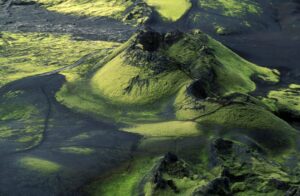This earthquake was not one of the subduction ones that are likely to hit this area in the future. Instead it occurred within the island, about ten miles west of Campbell River.
Vancouver Island’s largest historic earthquake, and Canada’s largest intra-plate quake, was a magnitude 7.3 event that occurred on Sunday, June 23, 1946, in the north central part of Vancouver Island. It caused a great deal of damage on Vancouver Island and was felt as far away as Portland, Oregon, and Prince Rupert, north of Vancouver Island, both places at a distance of three hundred miles.
The earthquake knocked down most of the chimneys in the closest communities, Cumberland, Union Bay, and Courtenay and did considerable damage in Comox, Port Alberni, and Powell River. Fortunately, because of the few people living in the area, casualties were very small, one due to drowning when a small boat capsized and the other from a heart attack in Seattle.
The epicenter was ten miles west of the town of Campbell River and tremors were felt all over Vancouver Island as well as on adjacent islands and the coastal areas of the mainland. It is always interesting to read accounts of earthquakes that were made before the 1960s, before there was any knowledge of the global tectonic plates that cause most of the big earthquakes. Such reports help us understand the perplexity that must have accompanied earthquakes from the dawn of history. In this case, experts visited Vancouver Island in 1946 after the earthquake, interviewing people in all the affected communities and thereby arriving at probably causes.
Their reports describe an epicentral region, rather than an epicenter, dominated by two fault lines extending north and south in the Strait of Georgia and east and west through Alberni. In both of these faults evidence for their existence is drawn substantially from surface features such as lakes and sea inlets. We know today that the tectonic boundaries that generate earthquakes in and around Vancouver Island lie far below the surface.
A damaging earthquake occurs somewhere in the Vancouver Island Region about once every twenty years. This one in 1946 was the largest of the twentieth century. Most of these earthquakes occur on the fault separating the sub ducting Juan de Fuca and North America plates. The greatest earthquake of the past several hundred years occurred on this fault in 1700 and it affected the entire coast from northern California to northern Vancouver Island. It had a magnitude of 9 or more. The lesser and more frequent earthquakes like this one in 1946 and a magnitude 7 quake in 1918 are intra-plate events, caused by stress within the crust of the North American Plate as it interacts with both the Juan de Fuca and Explorer plates lying off the west coast of Vancouver Island.
The data that is available on the 1946 earthquake is necessarily of the anecdotal kind since it was collected in 1946. There is a general and brief reference to serious damage in the areas described as the center of the earthquake. They consist of extracts from local newspapers. A much larger series of reports is taken from places at a distance from the epicenter, suggesting that the damage was greatest in these places. For example, tremors were experienced all over Vancouver Island. This is what we would expect if the causal factor had been general stress within the North American Plate.
Landslides were common all over the island according to the 1946 report. There were also widespread incidents of subsidence, almost all of them along coastal areas in the Strait of Georgia. Uplift of Vancouver Island in some areas along with subsidence elsewhere has always been a feature of the region, due to the ongoing subduction of the Juan de Fuca Plate under the North American Plate. Ships experienced the shaking that was happening in so many places, mostly in the Strait of Georgia but in one or two cases on the west coast. Their experiences were described as either having run over a sand bar or striking a rock.
Underwater cables were damaged in Alberni Inlet and in approaches to Powell River. All lighthouse keepers in the surrounding area reported shaking along with some damage, windows cracked and dishes broken. There was one report of a tsunami on the west side of Texada Island; two waves arrived, the first was seven feet high and the second four feet. One fortunate occurrence enabled researchers at a later time to reexamine the impact of the earthquake: an aerial photographic survey had been made of Vancouver Island in 1946, after the earthquake, and these were examined by a geologist in the late 1970s.
With the advances made in the intervening thirty years the epicenter was located more accurately than the estimated location of 1946, putting it significantly farther north and farther west. The two faults that had been identified in the earlier report were confirmed, but again they were located closer to the new epicenter. The evidence available from the aerial photography was entirely related to landslides. Large numbers of earth movements beyond what would have happened in the ordinary course of nature were clearly visible in these photographs but in the opposite set of locations compared to the area mentioned in 1946.
Because the reports from the people affected had come from areas of low elevation, the places where the main population centers are found, the author of the 1946 report concluded that most of the landslides had occurred there. He had also emphasized the amount of damage that had occurred on the east coast, within the Strait of Georgia, and on the coast of the mainland. The 1970s perspective is quite different. The vast majority of the landslides from 1946 were found on the west coast of the island from Barclay Sound northwards.
The reasoning that explains the sharp differences of interpretation between the two time periods relates to topography. The earlier report linked reports of damage to the earthquake, so it seemed that most of the landslides occurred in those areas. The places, however, where landslides would occur are those that have the greatest differences in elevation. That is, the vertical displacement of surface soil and rocks will always be at a maximum where the differences in elevation are greatest.
In the case of Vancouver Island, the chain of mountains that defines its highest terrain lies on its west coast so it was there that the aerial photographs revealed the majority of the landslides. Most of these landslides were directed toward the southwest. When the constant interaction at considerable depth between the offshore smaller plates and the North American Plate is taken into account, it is feasible to expect that the visible signs of the earthquake would be close to that interface rather than at one of the many interior fault lines.






















1 thought on “Vancouver Island Earthquake – Canada – June 23, 1946”
How much did it cost to repair it?
Rolfe